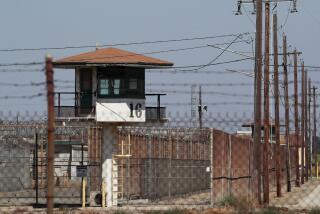Judge orders release of vulnerable inmates at Lompoc prisons hit by virus

- Share via
Federal prison authorities must begin transferring medically vulnerable inmates at Lompoc’s prison complex to home confinement to prevent further illness after an outbreak of the coronavirus killed four inmates and infected more than 1,000 others, a U.S. District Court judge ruled.
The decision last week by Judge Consuelo Marshall granted a preliminary injunction in a class-action lawsuit brought by the American Civil Liberties Union of Southern California that accuses the federal Bureau of Prisons of mishandling the response to the outbreak and two federal lockups in Lompoc of failing to take basic hygiene steps to protect those imprisoned. The two prisons house more than 3,700 low-level and medium security inmates.
Under the order, Bureau of Prisons officials are required to tell the court which inmates are eligible for release as part of a plan to reduce the population. Those eligible could be anyone older than 50, and anyone with underlying health conditions such as chronic obstructive pulmonary disease, serious heart conditions, diabetes, obesity, asthma or cerebrovascular disease.
“The court’s order is the first step in holding Lompoc prison officials accountable for their total failure to protect the health and safety of prisoners,” said Naeun Rim, the lead attorney representing the inmates.
Rim said prison officials admitted that, instead of releasing more nonviolent prisoners to home confinement, they moved inmates from one part of the prison to another and at one point cut off access to showers for nearly two weeks.
She said those actions contributed to the deaths of at least four people.
“The court’s order,” she said, “will result in less prisoners falling ill, reduce the burden on local hospitals, and ultimately make the surrounding community safer.”
In court papers, the ACLU said that, as of April, five dozen inmates had been considered for home confinement and 24 were scheduled to be released but that there had been no documented releases.
The lawsuit, filed May 16, alleges that overcrowding prevents prisoners from socially distancing or taking other precautions. Although the CARES Act, which became law March 27, gave the Bureau of Prisons broad discretion to reduce prison populations by releasing inmates into home confinement, its leadership failed to do that or follow Atty. Gen. William Barr’s order to release at-risk inmates to home confinement, the suit contends.
Lawyers for the Bureau of Prisons had asked the judge to dismiss the lawsuit. They noted that the bureau built a field hospital, adopted mass testing in May and that most of the inmates who did test positive showed no symptoms.
But after more than 70% of inmates at the low-security Lompoc facility tested positive, the judge found there was a “substantial risk of exposure to COVID-19, which is inconsistent with contemporary standards of human decency.”
Marshall found that the Bureau of Prisons had “likely been deliberately indifferent to the known urgency to consider inmates for home confinement, particularly those most vulnerable to severe illness or death.”
The number of those infected at the prison has now fallen to just a few, according to a Bureau of Prisons tracker. The four inmates who died after contracting COVID-19 are among 98 federal inmates to die nationwide, including 10 at Los Angeles’ Terminal Island federal prison.
In the ruling handed down July 14, Marshall gave the federal agency until July 29 to produce a sealed list of inmates eligible for release from the two Lompoc prisons.
In court papers, lawyers for the inmates document grave shortcomings in hygiene, including a lack of masks and cleaning materials. “When inmates asked for a replacement for their mask which had been damaged, they were told by correctional staff that they did not have any more masks,” the records said.
A former inmate in written testimony recalled: “Once guards brought 36 rags to be used by all 140 prisoners on his floor to clean their bunks, bathroom faucets, and toilet handles.”
More to Read
Sign up for Essential California
The most important California stories and recommendations in your inbox every morning.
You may occasionally receive promotional content from the Los Angeles Times.











